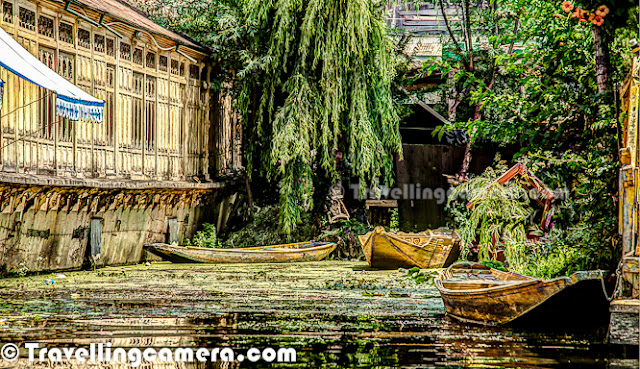Last month I was in Shrinagar for covering 3rd Mughal Rally which was organized by Himalayan Motrosports along with J&K Bank and J&K Tourism department. In 2012, it was 3rd Mughal Rally which is a two days event for Motorsport Enthusiasts. We were there at Shrinagar for three days, so managed to find time during one of the days to go for Shikara Ride in Dal Lake. This Photo Journey shares some of the phoptographs from this Shikara Ride in Dal Lake.
Above photograph shows Market inside the Dal Lake. It was wonderful moment to ride in a boat through Market built inside the Lake. There were many houses around the lake and almost every house owns a boat to commute from one place to another within Lake. FOlks were coming to this market in their own boats. Imagine a personal boat instead of personal car with a thought of commuting in that boat to all importantb places like Markets. Schools, Offices etc.
It was morning time around 9:30 am when we started from
our Hotel (Centaur). Varun, Sandeep and Sukant were accopnying for the
ride and two of them were also looking forward to get good shots from
this ride. Light was extremely harsh and we were extremely disappointed
with our laziness due to which we could not come early in the morning. I
was very frustrated but Sandeep and Varun kept motivating me to click
and take this as a new challenge. So we tried to capture some of the
elements from Dal Lake in Shrinagar. Dal Lake is a wonderful place to
shoot but timing to go there is extremely important, although this fact
is quite important while shooting in hills.
Our Shikara Ride started from Hotel Centaur which is located on the bank of Nagin Lake. Nagin Lake is connected to Dal Lake, so our Shikara moved towards Dal to show us Market of Old Kashmir. On the way from Nagin to Dal, there were lot of House-Boats on right side with wonderful facilities inside. Even from outside they were looking amrvelous. We could see seating place on terrace and few private baots/Shikaras standing in front of them. This is sort of different experience to stay in these houseboats with unique interiors and architecture. Above photograph shows one of the photographs of House-Boats in Dal Lake, Shrinagar, Jammu & Kashmir !!!
Lotuses are very special to Dal Lake and they are spear all around in different colors. White ones looked more beautiful to me, so shot above photograph. Various Houses, House-boats and Shops around Dal Lake keep proper care of these Lotuses.
While tourists enjoy their Shikara Rides in Dal Lake, many other boats/Shikaras can be seen around the lake who sell stuff to tourists. These Shikara Rides are longer so things to eat & drink can be very easily found there. ABove photograph shows two gentlemen selling 'Bhutta' in Dal Lake. Usually you see two people in such Shikaras/Boats - One who rides and other keep offering products to tourists.
Here is a photograph of lady taking some stuff to her home which is located on the banks of Dal Lake. This was very usual to local folks/children riding shikaras/boats in Dal Lake.
Here is a photograph showing some of the houses on shoreline of Dal Lake.
We also noticed different types of birds around the lake and different types of Ducks floating around House-boats.
Dal lake is popular as a visitor attraction and a summer resort. Fisheries and the harvesting of food and fodder plants are also important on Dal Lake. Weeds from the lake are extracted and converted into compost for the gardens. It also serves as a flood lung of the Jhelum River. During our riding we also noticed many machines working on cleaning project of Dal Lake.
Dal lake has numerous sites and places of interest, many of which are important to the cultural heritage of Srinigar. Aside from the Shalimar Bagh and Nishat Bagh, some of the other places frequented by tourists are the Shankaracharya temple, the Hari Parbat, the Nagin Lake, the Chashme Shahi, the Hazratbal Shrine, the famous Kashmir houseboat and the shikara (boat) called the Gandola of Kashmir.
If you liked this post and found it helpful, I would request you to follow these things when traveling -
- Manage your waste well and don’t litter
- Use dustbins. Tell us if you went to a place and found it hard to locate a dustbin.
- Avoid bottle waters in hills. Usually you get clean water in hills and water bottles create lot of mess in our ecosystem.
- Say big no to plastic and avoid those unhealthy snacks packed in plastic bags. Rather buy fruits.
- Don't play loud blaring music in forests of jungle camps. You are a guest in that ecosystem and disturbing the locals (humans and animals) is not polite

.jpg)
.jpg)

.jpg)









.jpg)